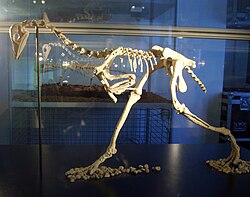| Patagopterygiforms Temporal range: Late Cretaceous, | |
|---|---|
 | |
| Skeleton restoration of Patagopteryx deferrariisi | |
| Scientific classification | |
| Domain: | Eukaryota |
| Kingdom: | Animalia |
| Phylum: | Chordata |
| Clade: | Dinosauria |
| Clade: | Saurischia |
| Clade: | Theropoda |
| Clade: | Avialae |
| Clade: | Euornithes |
| Clade: | † Patagopterygiformes Alvarenga & Bonaparte 1992 |
| Subgroups | |
| |
Patagopterygiformes is an extinct group of large terrestrial ornithuromorph dinosaurs from the Late Cretaceous of South America. It contains at most three genera: Patagopteryx , Alamitornis [1] and possibly Kuszholia . [2]









